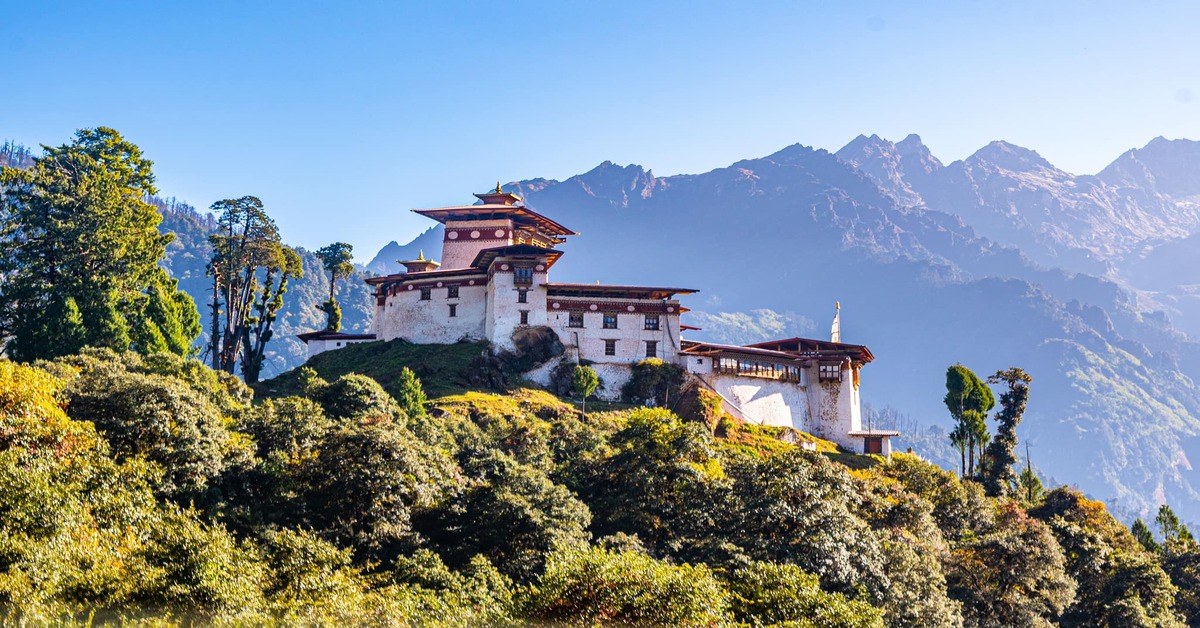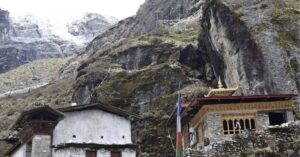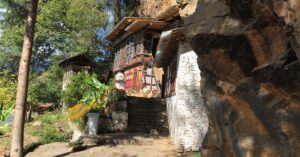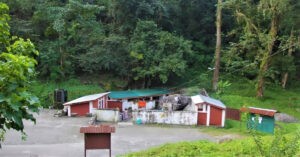Gasa Dzong, also known as Gasa Tashi Thongmon Dzong, is one of the 16 dzongs built by the Zhabdrung Ngawang Namgyal in Bhutan to commemorate the victories over the Tibetans in 1646. The Dzong was built on a hillock at an elevation of 2800 meters above the meditation cave of Drubthop Terkhungpa in Gasa Dzongkhag.
Gasa Dzong fortress later defended the country against several invasions from the north in the 17th and 18th centuries. Now, it is the administrative center of Gasa District.
How to Reach Gasa Dzong
The Gasa Dzong is reached from Punakha through a narrow dirt road. It takes about 3 hours from Punakha town.
History of Gasa Dzong
According to Gasa Dzong’s history, the entire landscape resembles the image of Tsheringma, the Goddess of long life. Drubthob Terkungpa established his meditation cave in the 13th century. The area was called Gasa, “the land of a blacksmith,” after Drupthop Terkungpa, an expert in blacksmithing.
Upon the command of Zhabdrung, Tenzin Drukdra, the second Druk Desi, built Gasa Dzong on the chest of the image of Tsheringma in 1646. In 1648, the Dzong was named Tashi Thongmon Dzong after its protective deity. It is said that Zhabdrung gave Damchen Gomo, the deity of Gasa, a new name, “Tashi Thongmon,” when he traveled to Tibet to greet Zhabdrung.
Later, Gyalse Tenzin Rabgye expanded the Dzong.
Also Read: History of Paro Rinpung Dzong, the Fortress on a Heap of Jewels
Significance of Gasa Dzong
Gasa Dzong is a significant cultural and historical landmark in Bhutan. It was built by Zhabdrung Ngawang Namgyal in 1646 and is renowned for its historical importance.
The fortress guarded the nation against multiple invasions from the north during the 17th and 18th centuries.
Also Read: Zhemgang Dzong, the Symbol of Unification of Khengrig Namsum
Description of Gasa Tashi Tongmon Dzong Complex
A steep staircase leads up to the Gasa Dzong, which is encircled by a tall stone wall. The traditional architecture of the dzong includes vibrant paintings and elaborate wood carvings.
Unlike most Dzongs, the Gasa Dzong fortress is built in a unique circular shape with three Ta Dzongs (watchtowers) placed differently at strategic locations. Explore the courtyard of the dzong and the several temples, which are embellished with exquisite sculptures and frescoes.
The majestic three-storied central tower (utse) is built directly above the meditation cave of Terkhungpa. To the left of the cave is the temple of Kap-Goenm, also known as Kazhimai Lhakhang, which contains the statues of Guru Rinpoche, the Zhabdrung Ngawang Namgyal, and the Buddhas of the past, present, and future. Gasa Dzong also houses Phulakha Lhakhang, Changzoe Lhakhang, the residence of Lamai Singye, and a monastic school.
Right below the Gasa Dzong is Lha Tsho, which translates to “soul lake”. According to local legend, when Tibetan invaders used guns to attack the Dzong, Damchen Gomo, the Dzong’s protector, appeared from this lake as a snake and saved the Dzong. Now, Eto Meto Garden surrounds the lake.
Also Read: Punakha Dzong, the Palace of Great Bliss on the Heaped Jewel
The Secret Tunnels of Gasa Dzong
It is said that three secret tunnels connect Gasa Dzong to the stream a few meters below the Dzong. However, only two are found. The tunnels were discovered when the residents were collecting stones from the tunnels to use in their construction in 2011. The ruined house, where the tunnels join, has huge stonewalls, almost the height of a two-story house that might have served as backup water storage.
These tunnels have walls that are two meters high, with a meter space between the inner walls. It is the longest and steepest tunnel, with almost 150 meters and more than 80-degree stone staircases. Starting from a ruined dwelling, 10m below the dzong, the tunnels end above the stream at two different locations.
It is said to have been used during wartime to fetch water. The watermill on the stream, which is believed to have been built by the Zhabdrung himself, indicates the tunnels may have been used to fetch water to the dzong. Next to the mill is a flat stone, which is considered the seat of Zhabdrung.
Also Read: Wangdue Phodrang Dzong, the Fortress of Glorious Unification
Gasa Tshechu Festival
The Gasa Dzong hosts the three-day annual Gasa Tshechu from the 8th to the 10th day of the 2nd month of the Lunar Calendar. Phulakha Lhakhang hosts the first day of the Tshechu. One of the highlights of the Tshechu is the Goen Zhey, a very popular dance drama originating in the time of Zhabdrung Rinpoche. The highland communities of Gasa also perform unique local folk dances. The festival ends with the unveiling of a Thongdrol.
Another festival is the gun salutations to Mahakala. On the 29th day of the 10th month, they offer gun salutations in Mahakala’s honor. During the ceremony, a Bon master in his full ritual attire participates in the offerings to the Mahakala. It is said that a Bon master in Gasa and Terkhungpa had a competition for spiritual attainment. The Bon master walked up the cliff easily, and Terkhungpa expressed his appreciation by offering to Mahakala.
Also Read: The Festival of Tashichho Dzong, a Fortress at the Site of Blue Stone Dzong
Best Time to Visit Gasa Dzong
The best time to visit Gasa Dzong is during the spring (March to May) and autumn (September to November) seasons, as the weather is pleasant, the landscapes are lush, and the trails are less muddy compared to the monsoon season (June to August). Time your trip here during the annual festival to immerse yourself deeply in the local culture, experience unique traditions, enjoy vibrant celebrations, and witness lively performances that might not be readily available during regular times, allowing for a richer and more meaningful travel experience. You can visit the major pilgrimage sites of Gasa with the Bhutan Pilgrimage Package.
Conclusion
Gasa Dzong, also known as Gasa Tashi Tongmön Dzong, is a significant historical site that offers visitors an insight into Bhutan’s rich cultural heritage. The fortress now serves as the administrative center of Gasa Dzongkhag. Tenzin Drukdra built the dzong in the 17th century over a site used by Drubthob Terkungpa to defend against invasions from the north.
Places to Explore in Gasa
Tshechu Drak: A sacred cliff of longevity water, where Guru Rinpoche is believed to have extracted water to benefit sentient beings. It is one of the four cliffs among the twelve meditation places entrusted to Phajo Drugom Zhigpo by Guru Rinpoche.
Gasa Tshachu: A renowned natural hot spring believed to cure ailments such as rheumatism, arthritis, ulcers, and indigestion. The Tshachu features multiple bathhouses and pools with varying water temperatures, attracting local and international visitors.
Enjoyed reading this blog?




